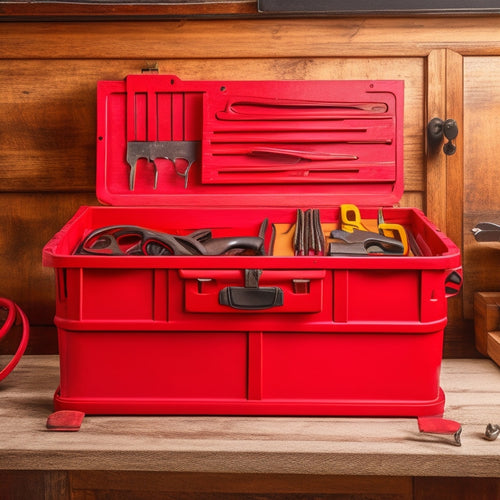
Efficient Inventory Management With a Parts Organizer
Share
You can revolutionize your inventory management process by implementing a parts organizer system, which streamlines operations, reduces errors, and enhances productivity. By organizing your stockroom, you'll quickly locate needed parts, minimize search times, and prevent safety hazards. Additionally, a parts organizer helps you identify slow-moving stock, optimize warehouse space, and improve order fulfillment. By maintaining accurate inventory tracking, you'll prevent stockouts and overstocking, and make informed decisions about inventory optimization. Now that you've taken the first step towards efficient inventory management, you're ready to access more benefits and strategies to take your business to the next level.
Key Takeaways
- An organized inventory system improves accuracy, reduces errors, and enables easy tracking and updates.
- Designated zones and clear labeling facilitate quick location of needed parts, reducing search times and lost productivity.
- Effective prioritization techniques and order classification ensure timely order fulfillment, increasing customer satisfaction and loyalty.
- Regular inventory reconciliation and a parts organizer system minimize shipping errors and enhance overall order fulfillment efficiency.
- Accurate inventory tracking with barcode scanning technology prevents stockouts and overstocking, improving operational efficiency and customer satisfaction.
Benefits of Organized Inventory
Since you're implementing a parts organizer to streamline your inventory management process, you're likely wondering what benefits you can expect from having an organized inventory.
One significant advantage is improved inventory accuracy. With a well-organized system, you can easily track and update your inventory levels, reducing errors and discrepancies. This accuracy also enables you to identify slow-moving or dead stock, allowing you to make informed decisions about inventory optimization.
Another benefit is enhanced parts accessibility. When your inventory is organized, you can quickly locate the parts you need, reducing search times and increasing productivity. This is particularly important in high-pressure environments where downtime can be costly.
Reducing Stockroom Chaos
Among the most pressing challenges of inventory management lies the issue of stockroom chaos, where disorganization and clutter can lead to lost productivity, wasted resources, and even safety hazards. You're not alone in this struggle, but it's vital to tackle it head-on.
When you implement effective stockroom organization, you'll be amazed at the chaos reduction that follows. Start by designating specific zones for different types of inventory, ensuring that each item has a designated home. This will help you quickly locate what you need, reducing the time spent searching for misplaced parts.
Labeling and categorizing your inventory is also important. Use clear and concise labels, and consider color-coding to differentiate between various product lines or categories. This will enable you to identify what you have in stock at a glance, preventing over-ordering and reducing waste.
Streamlining Order Fulfillment
You're now ready to take your inventory management to the next level by streamlining order fulfillment.
This means you'll be filling orders on time, reducing shipping errors, and optimizing warehouse space.
Filling Orders on Time
About 80% of customers consider timely order fulfillment a critical factor in their purchasing decisions, making it essential to optimize your order fulfillment process. To fill orders on time, you need to implement effective order prioritization techniques and timely delivery strategies.
| Priority Level | Order Characteristics |
| High | Urgent orders, high-value items, or critical components |
| Medium | Standard orders, medium-value items, or non-critical components |
| Low | Non-urgent orders, low-value items, or non-essential components |
| Rush | Same-day or next-day delivery orders |
| Backorder | Out-of-stock items or delayed delivery orders |
Reducing Shipping Errors
A well-organized warehouse is the backbone of efficient order fulfillment, and shipping errors can quickly undermine even the best-laid plans. You can't afford to have incorrect or missing items in your shipments, as this can lead to costly returns, damaged relationships with customers, and a blow to your reputation.
To reduce shipping errors, you need to focus on shipping accuracy. This starts with accurate inventory reconciliation, where you regularly check your stock levels to guarantee they match your records. By doing so, you can identify and correct discrepancies before they cause problems.
Implementing a parts organizer system can also help you streamline your shipping process by providing a clear and organized system for picking and packing orders. With a parts organizer, you can quickly locate the items you need, reducing the risk of mistakes.
Optimizing Warehouse Space
Every spare inch of warehouse space counts when it comes to streamlining order fulfillment. You need to make the most of your available space to guarantee efficient inventory management. By optimizing your warehouse layout, you can reduce congestion, improve accessibility, and increase productivity.
One effective way to do this is by utilizing vertical storage solutions. These allow you to maximize your ceiling height, storing less frequently used items above more accessible shelves. This not only frees up floor space but also reduces the risk of accidents caused by cluttered aisles.
Modular shelving systems are another great option. These customizable systems can be customized to fit your specific storage needs, providing a flexible and adaptable solution as your inventory changes. They also promote better organization, making it easier to locate and retrieve items quickly.
Accurate Inventory Tracking
Through careful record-keeping, you can pinpoint discrepancies in your inventory and eliminate stockouts or overstocking, ensuring that your operations run smoothly.
Accurate inventory tracking is essential to maintaining a well-organized warehouse. By implementing a reliable tracking system, you can monitor your inventory levels in real-time, allowing you to make informed decisions about restocking and ordering.
Barcode scanning technology can streamline the tracking process, reducing errors and saving time. With real-time updates, you'll always have an accurate representation of your inventory, enabling you to respond quickly to changes in demand or supply.
This level of precision also helps you identify slow-moving items, allowing you to adjust your inventory accordingly. By maintaining accurate inventory levels, you'll reduce the risk of stockouts, overstocking, and associated costs.
This, in turn, will improve your overall efficiency, customer satisfaction, and bottom line.
Minimizing Overstocking Errors
By maintaining accurate inventory levels, you're well-equipped to tackle another common pitfall: overstocking. This occurs when you have more stock than you need, resulting in wasted resources and potential safety hazards.
To minimize overstocking errors, you should conduct regular stock analysis to identify slow-moving or dead stock. This allows you to make informed decisions about what to restock and what to discontinue.
Demand forecasting is another essential tool in preventing overstocking. By analyzing historical sales data and seasonal trends, you can accurately predict future demand and adjust your inventory accordingly. This guarantees you have the right stock in the right quantities, reducing the risk of overstocking.
Additionally, implementing a just-in-time (JIT) inventory system can help minimize overstocking errors. With JIT, you order and receive stock as needed, rather than holding large quantities in storage. This approach reduces waste, saves space, and streamlines your inventory management process.
Efficient Use of Warehouse Space
Optimizing warehouse space is essential for efficient inventory management. You need to make the most of your available space to reduce clutter, improve accessibility, and enhance overall safety. By implementing effective space utilization strategies, you can greatly reduce the risk of accidents and injuries.
To maximize your warehouse space, consider the following solutions:
| Storage Solution | Benefits | Ideal For |
|---|---|---|
| Vertical Storage Racks | Increases storage capacity, reduces floor space | Bulky or heavy items, high-volume storage |
| Shelving Units | Easy access, flexible storage options | Small to medium-sized items, frequent inventory rotation |
| Mobile Storage Containers | Compact, portable storage | Infrequently used items, seasonal inventory |
Simplifying Inventory Audits
When you're preparing for an inventory audit, you know how essential it's to have a solid plan in place.
That's why creating an audit preparation checklist can help guarantee you're covering all your bases.
Audit Preparation Checklist
Get ahead of the game by pulling together an audit preparation checklist to simplify your inventory audits. This checklist will guarantee you're well-prepared for the audit process, reducing stress and increasing efficiency.
Start by defining your audit frequency, responsibilities, and timeline to establish a clear plan of action. Identify the audit team members and their roles to guarantee a smooth process.
Determine the necessary audit documentation, such as inventory records and transaction history, and organize them in a way that's easily accessible. Consider investing in audit software to streamline the process and improve accuracy.
Establish a clear audit methodology, including the tools and methods you'll use to collect and analyze data. Define the expected audit findings and compliance requirements to guarantee you're meeting all necessary standards.
Streamlined Counting Process
You've taken the first step towards a successful audit by preparing a thorough checklist.
Now, it's time to streamline your counting process to guarantee inventory accuracy.
To simplify your counting process, apply these techniques:
-
Zone counting: Divide your inventory into smaller sections or zones to focus on one area at a time, reducing the likelihood of errors.
-
Counting in batches: Group similar items together to count in batches, making it easier to track and record quantities.
-
Using counting aids: Employ tools like barcode scanners or counting scales to speed up the process and reduce manual errors.
- Double-counting: Have a second person verify counts to confirm accuracy and catch any discrepancies.
Optimizing Supply Chain Logistics
Supply chain logistics optimization is a significant step in inventory management, as it directly impacts your bottom line. You can't afford to overlook this essential aspect, as inefficient logistics can lead to stockouts, overstocking, and delayed deliveries.
By streamlining your supply chain, you'll reduce transportation costs, minimize inventory holding costs, and improve overall logistics efficiency.
To optimize your supply chain, you need to analyze your current logistics operations and identify areas for improvement. Look for opportunities to consolidate shipments, renegotiate with suppliers, and implement just-in-time delivery systems.
Implementing a parts organizer can also help you better track inventory levels, reducing the risk of stockouts and overstocking.
Improved Customer Satisfaction
By having a well-organized inventory management system in place, you're better equipped to meet customer demands promptly, leading to improved customer satisfaction.
This, in turn, leads to increased customer loyalty and repeat business.
When you can deliver products quickly and efficiently, you're more likely to receive positive customer feedback.
This feedback is crucial, as it allows you to identify areas for service improvements.
Here are some key benefits of improved customer satisfaction:
- Increased customer retention: Happy customers are more likely to return for future purchases, reducing the need for costly marketing efforts to attract new customers.
- Positive online reviews: Satisfied customers often leave positive reviews, which can attract new customers and increase your online reputation.
- Word-of-mouth referrals: Happy customers are more likely to recommend your business to friends and family, leading to increased sales and growth.
- Competitive advantage: By prioritizing customer satisfaction, you can differentiate your business from competitors and establish a reputation for exceptional service.
Maximizing Profit Margins
Effective inventory management with a parts organizer enables you to maximize profit margins by reducing waste, minimizing stockouts, and enhancing pricing strategies.
By implementing cost reduction strategies, you can eliminate unnecessary expenses and allocate resources more efficiently. For instance, you can identify slow-moving inventory and liquidate it to free up capital. Additionally, a parts organizer helps you maintain accurate inventory levels, reducing the risk of overstocking and stockouts.
To further increase profit margins, you can employ pricing enhancement techniques. Analyze market trends and competitor pricing to determine the best price for your products.
A parts organizer allows you to track inventory levels and adjust pricing accordingly. For example, you can offer discounts on slow-moving items or increase prices during peak demand periods.
Frequently Asked Questions
Can I Customize My Parts Organizer to Fit My Specific Business Needs?
You can tailor your parts organizer to fit your unique business requirements by exploring various customization options, such as adjustable shelving, label editing, and data filtering, to create a system that efficiently meets your specific needs.
How Do I Determine the Optimal Bin Size for Each Inventory Item?
Imagine a perfectly crafted puzzle: you're the expert builder, and each piece represents an inventory item. To find the ideal bin size, you'll weigh size, quantity, and frequency of use, applying inventory optimization techniques to guarantee a snug, safe fit, and a clutter-free workspace.
Are Parts Organizers Compatible With Existing Inventory Management Software?
You'll find that most parts organizers are designed to integrate with existing inventory management software, but you'll need to check the features and compatibility before investing, as software compatibility challenges can arise if not properly vetted.
Can a Parts Organizer Be Integrated With Barcode Scanning Systems?
As you streamline your supply chain, silky scanning sequences unfold, and you'll find that yes, you can seamlessly integrate a parts organizer with barcode scanning systems, amplifying scanning efficiency and ensuring accurate inventory tracking.
How Often Should I Review and Update My Parts Organizer System?
You should review your parts organizer system regularly, ideally weekly or bi-weekly, to guarantee accuracy and relevance, and update procedures as needed to maintain a reliable and safe inventory management process.
Conclusion
You may think organizing your inventory is a tedious task, but the benefits far outweigh the effort. By implementing an efficient parts organizer, you'll save time, reduce costs, and enhance customer satisfaction. Yes, it may require an initial investment, but think of it as a one-time cost that will pay for itself in the long run. With accurate tracking and minimized overstocking, you'll be able to maximize your profit margins and stay ahead of the competition.
Related Posts
-

10 Best Tool Boxes for Every Budget and Job
You're looking for a tool box that fits your budget and job requirements. Whether you're a DIY enthusiast, electricia...
-

Portable Tool Chest Essentials
When stocking your portable tool chest, you'll want to prioritize essential hand tools like hammers, tape measures, a...
-

Modular Garage Organizers for Clutter-Free Spaces
You're likely wasting precious space in your garage due to inefficient storage and poor organization, but modular gar...


